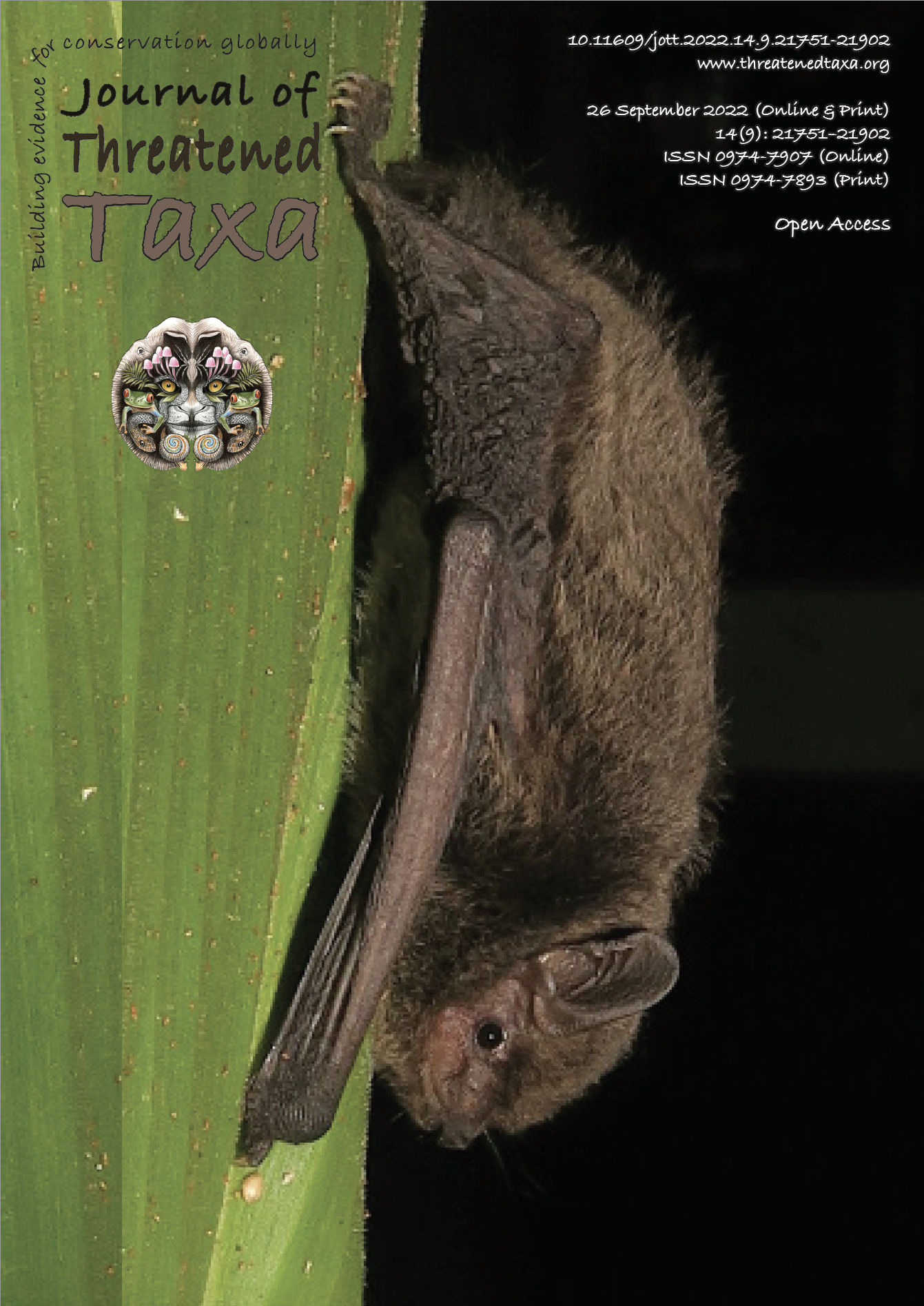Woody plant wealth of Therikadu Reserve Forest, Tuticorin, India: a checklist
Main Article Content
Abstract
A qualitative survey was conducted to record the woody plant wealth of Carnatic Umbrella Thorn Forest (CUTF) existing within the Therikadu Reserve Forest (TRF), Tuticorin district, southeastern Coast, Peninsular India. A sum of 35 man-days was spent on the field to prepare a woody plant checklist. All collected specimens were identified up to the species level with the help of floras. A sum of 105 species belonging to 83 genera in 37 families were recorded from the study area. The family Fabaceae represented by a large number of species (36 species) followed by Bignoniaceae (5) and Rubiaceae (4). Eight families represented by three species each, while 16 families represented by a single species each. CUTF acts as a home for one of the IUCN’s endangered species, Pterocarpus santalinus. The reserve forest and sacred grove status are keeping TRF as an intact and relatively undisturbed ecosystem.
Article Details

This work is licensed under a Creative Commons Attribution 4.0 International License.
Authors own the copyright to the articles published in JoTT. This is indicated explicitly in each publication. The authors grant permission to the publisher Wildlife Information Liaison Development (WILD) Society to publish the article in the Journal of Threatened Taxa. The authors recognize WILD as the original publisher, and to sell hard copies of the Journal and article to any buyer. JoTT is registered under the Creative Commons Attribution 4.0 International License (CC BY), which allows authors to retain copyright ownership. Under this license the authors allow anyone to download, cite, use the data, modify, reprint, copy and distribute provided the authors and source of publication are credited through appropriate citations (e.g., Son et al. (2016). Bats (Mammalia: Chiroptera) of the southeastern Truong Son Mountains, Quang Ngai Province, Vietnam. Journal of Threatened Taxa 8(7): 8953–8969. https://doi.org/10.11609/jott.2785.8.7.8953-8969). Users of the data do not require specific permission from the authors or the publisher.
References
Champion, H.G. & S.K. Seth (1968). A revised Survey of the Forest Types of India. Government of India Press, New Delhi, India, 404 pp.
Evitex-Izayas, J. & M. Udayakumar (2021). Density, diversity and community composition of trees in tropical thorn forest, peninsular India. Current Botany 12: 138-145.
Gamble, J.S. & C.E.C. Fischer (1921–35). Flora of the Presidency of Madras. 3 Vols. Adlard and Son Ltd, London, 1864 pp.
Matthew, K.M. (1991). An excursion Flora of Central Tamil Nadu. Rapinat Herbarium, Thiruchirappalli, India, 647 pp.
Montagnini, F. & C.F. Jordan (2005). Tropical Forest Ecology: The Basis for Conservation and Management. Springer, Heidelberg, Germany, 295 pp.
Nagaraj, M. & M. Udayakumar (2021). Aboveground Biomass Stockpile of Trees in Southern Thorn Forest, Tuticorin. Current World Environment 16(3): 755–763.
Nair, N.C. & A.N. Henry (1983). Flora of Tamil Nadu, India. Series I: Analysis. Vol. 1. Botanical Survey of India, Coimbatore, India, 184 pp.
Nair, N.C. & S.R. Srinivasan (1981). Observation on the botany of Ramanathapuram district, Tamil Nadu. The Bulletin of the Botanical Survey of India 23(1-4): 74-78.
POWO (2021). https://powo.science.kew.org/. Accessed on June 2022.
Selvakumari, R. & T.J.S. Rajakumar (2012). Wild edible plants of Kudiraimozhi theri in Tuticorin district, Southern India. Journal of Non-Timber Forest Products 19(3): 245-246.
Singh, M., D.G. Lindburg, A. Udhayan, M.A. Kumar & H.N. Kumara (1999). Status survey of slender loris Loris tardigradus lydekkerianus in Dindigul, Tamil Nadu. Oryx 33(1): 31–37.
The Plant List (2021). http://www.theplantlist.org/. Accessed on May 2021.
Thoothukudi District Website (2021). https://thoothukudi.nic.in/. Accessed on May 2021.
Tiwari, U.L. & K. Ravikumar (2018a). Floristic diversity and vegetation analysis of plants from various forest types in Hosur Forest Division, Tamil Nadu, southern India. Notulae Scientia Biologicae 10(4): 597–606.
Tiwari, U.L. & K. Ravikumar (2018b). Floristic diversity, vegetation analysis and threat Status of plants in various forest types in Dharmapuri Forest Division, Tamilnadu, southern India. Notulae Scientia Biologicae 10(2): 297–304.
Udayakumar, M. & N. Parthasarathy (2010). Angiosperms, tropical dry evergreen forests of southern Coromandel coast, India. Check List 6: 368–381.
Udayakumar, M. & T. Sekar (2017). Estimation of Leaf Area–Wood Density Traits Relationship in Tropical Dry Evergreen Forests of Southern Coromandel Coast, Peninsular India, pp. 169-187. In: Pandey, K., V. Ramakantha, S. Chauhan, A.A. Kumar (Eds.). Wood is Good, Springer, Singapore, 480 pp.
Venkatesh, A., N. Sridharan, S.A.J. Packiavathi, K.M. Selvan (2021). Occurrence of mammalian small carnivores in Kalakad-Mundanthurai Tiger Reserve, Western Ghats, India. Journal of Threatened Taxa 13(3): 17984–17989. https://doi.org/10.11609/jott.3670.13.3.17984-17989
Venu, U.A. & P. Velmayil (2021). Texture, minerology and geochemistry of Teri sediments from Kuthiraimozhi deposit, Southern Tamil Nadu, India. Arabian Journal of Geosciences 14(5): 1–15.

